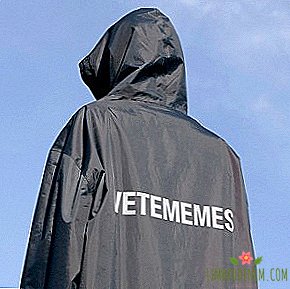Economy: Is it true that people stopped buying clothes
RECENTLY THE WORLD SEARCHED IN NEWS ABOUT THE POSCHIVE FINANCIAL CONDITION Swedish brand H & M. It seemed that such mass-market giants are absolutely unbreakable. However, in March, the company submitted a report on a drop in profits in the first quarter by 60%, while its shares fell by 6%, reaching the lowest level since 2005. While experts argue about what caused such a sharp jump, we understand why this is not an isolated case, what retailers should prepare for and what the clothing market may become in the near future.

As we began to spend less on clothes
About a change in purchasing behavior around the world started talking a couple of years ago. For the first time in seven years, people began to spend less on clothes and go shopping.. The market was oversaturated, and the typical buyer finally decided to do without a regular pair of blue jeans. If he makes a purchase, then during the period of discounts, which today practically do not end there: the collections are updated so often that things are not bought, and there is nothing left for shops like Zara how to constantly lower prices.
The edition of The Business Of Fashion has compiled a list of the rules of “new consumerism”, which were put forward by the buyers themselves - if offline stores somehow fail to match it, they will most likely suffer losses or close altogether. For example, people are really tired of buying the same things from season to season: today they want to invest in a better and more long-lasting product - emotions and experience. To attract the attention of the audience, the stores hold meetings with industry experts, lectures, cocktails and dance parties. The structure of demand is also changing: studies among adolescents show, for example, that they will be spent on food and cosmetics rather than on things.
For the first time in seven years, people began to spend less on clothes and go shopping.
In addition, today it is important for more and more people to know that clothes are produced and sold in environmentally friendly and ethical ways. Companies are required not only to provide them, but also to make this process transparent. H & M Group in its latest report has already stated that by 2030 it will completely switch to environmentally friendly or recycled materials (now their share is 35%). The company continues to blame the fact that it burns unsold, but wearable clothing. Right now, for example, the fate of the extra goods worth four billion dollars, which the company is trying to implement, is being decided.
In Russia, too, they buy less, but rather because of falling incomes. According to a study by Ipsos Comcon, in 2016, every second person saved on clothes and shoes, almost half of the country's residents refused to shop at all. Experts say that the real incomes of Russians have been falling for four years now and the situation is unlikely to change anytime soon. "Changes in the exchange rate also do not give grounds for bright forecasts, moreover, most of the clothes and shoes are imported. Various unpredictable factors also interfere: for example, last year there was a cold summer and warm winter, and as a result, sales of seasonal collections were lower than expected At the end of 2017, experts agree on one thing - the market showed zero growth, and if inflation is taken into account, it is generally negative, "says co-founder of the Dear Progress agency and brand manager of Etam and Undiz in Russia Ekaterina Petukhova.

Shops close in bulk
If earlier huge stores and the widest choice were the key to success, today these criteria seem to be able to drown business on the contrary. People no longer want to spend time and energy on studying the range in the mass market: too many items, too much difference between the picture on the Internet and the thing on the hanger. Today, the buyer is more likely to go for quality clothing to already proven brands with convenient service, when you can place an order in minutes using the mobile app, than spend time at the mall after work.
Monobrand stores are also closing around the world. In 2017, about 8,600 retail outlets in the US alone came under distribution, in 2018 about twelve thousand could close. Thus, Macy's American network is going to abandon sixty-three stores and lay off ten thousand employees. Adidas also intends to close the sales points, explaining that in this way it will improve the quality of existing stores and focus on online trading. The Spanish network Inditex, which owns the Zara, Bershka, Massimo Dutti and Uterqüe brands, also announces that small outlets will soon be closing in order to develop large stores and sales on the Internet.
People no longer want to spend time and energy on the study of the range in the mass market: too many items
"Any business has a ceiling of growth in the geographic market. For example, adidas has about eight hundred stores across Russia openly. Now consider that in our country, if I'm not mistaken, there are ninety-four cities with a population of more than two hundred thousand people. That is, even the brand has only three hundred stores, it will inevitably go into small cities with a small profitability, what can we say about the grid of eight hundred points.
Any fall and crisis for an established, developed business is like a disaster. As you do not drag a TV and a sofa with you, and retailers will throw off all the "heavy" assets. Unprofitable stores among them. The number of stores is not a matter of pride, much more important is your margin and revenue per square.
One of the illustrative examples is the bankruptcy of the once market leader, CenterObuv, with more than a thousand stores. Now none of the leaders is seeking to take their place. Everyone understands that a large network is a huge transaction cost and management complexity, "says Petukhova.

But everything is not so bad
It would be a mistake to believe that all large networks are failing today. Often brands are faced with low sales, because they do not have time to adapt to the rapidly changing interests of the audience, but this does not mean that everything is lost. For example, Prada's profits have fallen since 2014, but now the management of the luxury brand hopes to return to the rut due to the release of new items of clothing, including sneakers. Experts attribute the growth in sales of Calvin Klein to the arrival of Raf Simons, who focused on creating concept clothing and attracting Instagram stars to the advertising campaigns. The same can be said about the luxury giant Gucci, the aesthetics of which has changed markedly with the advent of Alessandro Mikkele: memorable outfits and vivid displays ensured sales of more than six billion euros in 2017.
"The market has been restructuring between segments, players, sales channels for several years. Simply put, if I sell more than you, not because people started buying more, but because I managed to lure your customers. Today we are watching in the market, how strong and flexible players become even stronger, and weak ones gradually lose their positions, "says Ekaterina Petukhova.
I sell more, not because people started buying more, but because I managed to lure your customers
Obviously, the most influential market participants will be those who have time to both optimize their offline retail and develop competent sales on the Internet. Experts predict, for example, that online trade in luxury goods will reach seventy-four billion euros by 2025, which is three times more than now. Online retailer Amazon is preparing to capture almost 20% of the clothing market in the US by 2021. ASOS will have to catch up, which is already investing four billion pounds in logistics and distribution. In the past six months alone, more than one billion people have visited this site.
It seems that very soon we will see the very future retail who is already trying to create, for example, Farfetch, bought London Browns, - offline platforms with automated systems that act as your personal shop assistant or stylist (in such a system the seller, for example, sees that the customer has acquired before). It is possible that the main assortment in such a store will be made from recycled materials or will be vintage. But this is definitely not the near future.
Photo:lulu - stock.adobe.com, connel_design - stock.adobe.com, H & M





